On January 9th after an already long and busy day, we went to the Kennedy Center to watch a production of the Washington National Opera in “3 new 20-minute Operas”. Being 62 years old, there’s a lot of history to the opera but I’ll try to go through it as brief as possible.
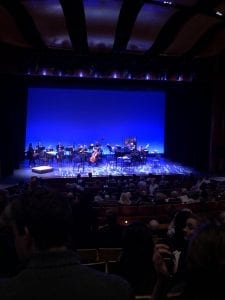
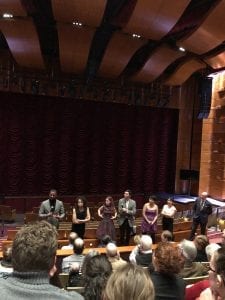
The Orchestra warming up before the opera started and the composers and librettists of the opera’s answering questions after the performances.
The Washington National Opera has a long and interesting history after being established in 1957 as the Opera Society of Washington by Day Thorpe. As the music critic of the then most influential Washington newspaper “The Washington Star”, his opera society quickly gained attention. By 1958 only a year after being established, the Opera Society of Washington was already known around the nation. Paul Callaway was the first music director of the opera and insisted on only traditional opera to be performed with no “fat sopranos”, “self-centered tenors”, no cutting of scores, no expensive scenery, and no opera in English. At this time there was no traditional company and for each new production the two had to find new financial support, new performers, and new musicians. The next 10 years for the opera were filled with up and downs and with “a fiasco of unforgivable proportions” of an English-language magic flute performance, Paul Callaway resigned.
1966 to 1977 were filled with changes to the opera to try to bring excitement to the company. In 1972 the general manager focused on changing the structure of the Opera to be more businesslike and consistently bring in funds and grants for productions. Also in 1972 the opera moved into the newly created Kennedy Center where it still is today.
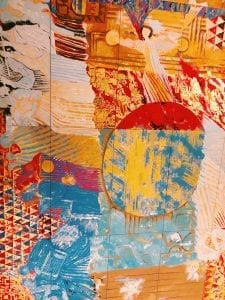
Ceiling in the Israeli lounge of the Kennedy Center
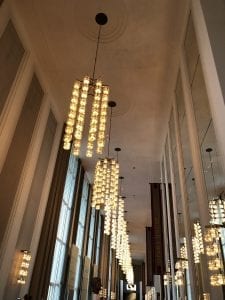
The Grand Foyer with 16 Orrefors crystal chandeliers. Each are 15 feet long, 7 feet wide, and a weigh one ton.
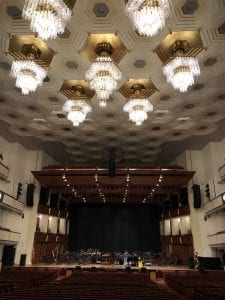
Concert Hall in Kennedy Center
After moving into the Kennedy Center, the opera was doing very well and was run by many different general directors. In 2000 congress passed a bill designating the company as America’s National Opera and in 2004 the name of the opera was changed to Washington National Opera to reflect this. Starting in 2011, the Kennedy Center took control of the Washington National Opera. Now, the Washington National Opera is a part of the Kennedy Center with Evan Rogister as the principal director through the 2021-2022 season.
Going into the night, I had no idea what to expect. I had never been to an opera and didn’t know much about what an opera is besides the research I did on the history of the Washington National Opera. I thought the stories told through opera would be big and exaggerated stories from times where there were kings and knights. I was very wrong and surprised how normal and common stories can be told through opera. The three opera’s we saw were about a girl getting into college and trying to convince her father to let her go to a school out of the country, the college admissions scandals of lately, and black world war two veterans traveling south facing police brutality. Each opera was a story familiar to one’s I’ve heard about in my own life and I was surprised how something as big as opera could tell these seemingly normal stories.
As a part of the federal government I’m curious if that plays a part in the stories they are allowed to tell and if censorship ever plays a role. As America’s National Opera, they represent and define our country and the people who live inside of it. They play an important role of showing both those in and outside of our country what is valued by our people and who we are. They have a great responsibility to accurately represent the country and change as our country changes. I was unable to find any information about this online but I’m curious if apart from the Kennedy Center the Washington National Opera has a separate mission statement or goals.
I want to end this blog post with a discussion on accessibility. The Kennedy Center’s mission statement is, “As the nation’s center for the performing arts, the Kennedy Center is committed to increasing opportunities for all people to participate in and understand the arts. To fulfill that mission, the Center strives to commission, produce, and present performances reflecting the highest standards of excellence and diversity indicative of the world in which we live, and to make those performances accessible to the broadest possible audience through arts education”. Being in the Kennedy Center, there are great resources for people with disabilities and various free performances once a day. However, tickets for America’s Opera the Washington National Opera range from $50 to $200. Prices to join one of the many membership circles range from $1,800 to $50,000 a year. As a federal entity, does the Washington National Opera have a responsibility to allow low income community members to experience performances that define our nation? Additionally, as a federal entity is it important for the Washington National Opera to increase inclusivity and opportunities for low income community members? Having a permanent location and substantial monetary resources, why has the opera not made efforts to include this large population?
Works Cited:
Cusick, Robert I. “The Kennedy Center for the Performing Arts.” Received by Designated Agency Ethics Officials, 10 Nov. 2009.
“Kennedy Center Education Mission & Arts Education Vision Statement.” Kennedy Center: Education Program Mission Statement, education.kennedy-center.org/education/mission.html.
“The John F. Kennedy Center for the Performing Arts.” The Kennedy Center, www.kennedy-center.org/wno/index.
Wikipedia contributors. “Washington National Opera.” Wikipedia, The Free Encyclopedia. Wikipedia, The Free Encyclopedia, 3 Dec. 2019. Web. 11 Jan. 2020.
“Your Red Carpet Experience Awaits.” Membership | The John F. Kennedy Center for the Performing Arts, cms.kennedy-center.org/support/membership#levels.
